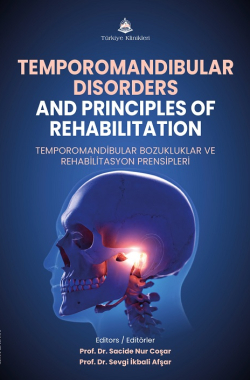A CAUSE OF SECONDARY OTALGIA: TEMPOROMANDIBULAR DISORDERS
Gülfem Beyazpınar
Başkent University, Faculty of Medicine, Department of Otorhinolaryngology, Ankara, Türkiye
Beyazpınar G. A Cause of Secondary Otalgia: Temporomandibular Disorders. In: Coşar SN, Afşar Sİ editors. Temporomandibular Disorders and Principles of Rehabilitation. 1st ed. Ankara: Türkiye Klinikleri; 2025. p.35-40.
ABSTRACT
Temporomandibular joint dysfunctions (TMD) are neuromuscular disorders that affect the masticatory muscles and the joint itself. These conditions can lead to a range of complaints, including joint pain, crepitus, asymmetric mandibular movement, and otological symptoms. Secondary otalgia arising from TMD often triggers chronic pain processes, reducing the quality of life. The anatomical proximity of the joint and the ear means that as the severity of TMD increases, otalgia becomes more pronounced. In TMD, otalgia typically results from the innervation of the trigeminal nerve and other cranial nerves associated with the ear. Additionally, parafunctional activities such as stress, teeth clenching, and bruxism are influential factors in the development of the disorder. Treatment generally starts with conservative approaches, including muscle relaxants, anti-inflammatory drugs, and the use of occlusal splints. Furthermore, methods like hot compresses, physical therapy, and stress management can help reduce pain. Advanced treatments such as botulinum toxin may also be beneficial for some patients. Early diagnosis and appropriate treatment are crucial in controlling otalgia in TMD cases.
Keywords: Earache; Temporomandibular joint disorders; Myalgia; Bruxism; Tooth wear
Kaynak Göster
Referanslar
- Tavares LF, Gadotti IC, Melo RA, Moura ABG, Ferreira LM, Figueiredo-Ribeiro KMOB. Quality of life and level of physical activity of individuals with temporomandibular disorders with and without otological symptoms: Secondary analysis of a cross-sectional study. Physiother Res Int. 2024;29(3):e2104. [Crossref] [PubMed]
- Hernández-Nuño de la Rosa MF, Keith DA, Siegel NS, Moreno-Hay I. Is there an association between otologic symptoms and temporomandibular disorders?: An evidence-based review. J Am Dent Assoc. 2022;153(11):10961103. [Crossref] [PubMed]
- Naderi Y, Karami E, Chamani G, Amizadeh M, Rad M, Shabani M. Temporomandibular treatments are significantly efficient in improving otologic symptoms. BMC Oral Health. 2023;23(1):913. [Crossref] [PubMed] [PMC]
- Ramazani F, Szalay-Anderson C, Batista AV, Park P, Hwang E, Chau J et al. Referred otalgia: Common causes and evidence-based strategies for assessment and management. Can Fam Physician. 2023;69(11):757-761. [Crossref] [PubMed] [PMC]
- Maciel LFO, Landim FS, Vasconcelos BC. Otological findings and other symptoms related to temporomandibular disorders in young people. Br J Oral Maxillofac Surg. 2018;56(8):739-743. [Crossref] [PubMed]
- Salvetti G, Manfredini D, Barsotti S, Bosco M. Otologic symptoms in temporomandibular disorders patients: is there evidence of an association-relationship? Minerva Stomatol. 2006;55(11-12):627-37. English, Italian. [PubMed]
- Earwood JS, Rogers TS, Rathjen NA. Ear pain: diagnosing common and uncommon causes. Am Fam Physician. 2018;97(1):20-27. [Crossref]
- Winocur E, Gavish A, Finkelshtein T, Halachmi M, Gazit E. Oral habits among adolescent girls and their association with symptoms of temporomandibular disorders. J Oral Rehabil. 2001;28(7):624-9. [Crossref] [PubMed]
- Huang GJ, LeResche L, Critchlow CW, Martin MD, Drangsholt MT. Risk factors for diagnostic subgroups of painful temporomandibular disorders (TMD). J Dent Res. 2002;81(4):284-8. [Crossref] [PubMed]
- Cheng P, Ma X, Li S. [Histologic study of the temporomandibular joints after ovariectomy in rats]. Zhonghua Kou Qiang Yi Xue Za Zhi. 2000;35(6):458-61. Chinese. [PubMed]
- Wang G, Feng Y, Tang JQ, Zhang JJ, Wang XQ. Measurement and analysis of condylar morphology and thickness of the roof of the glenoid fossa in patients with unilateral second molar scissor bite. Sci Rep. 2024;14(1):24747. [Crossref] [PubMed] [PMC]
- Abbass MMS, Rady D, El Moshy S, Ahmed Radwan I, Wadan AS, Dörfer CE, et al. The Temporomandibular Joint and the Human Body: A New Perspective on Cross Talk. Dent J (Basel). 2024;12(11):357. [Crossref] [PubMed] [PMC]
- Stepan L, Shaw CL, Oue S. Temporomandibular disorder in otolaryngology: systematic review. J Laryngol Otol. 2017;131(S1):S50-S56. [Crossref] [PubMed]
- Honorato MCM, Tavares LF, Bedaque HP, Mantello EB, Almeida EO, Ribeiro KMOBF, et al. Otoneurological assessment and quality of life of individuals with complaints of dizziness and temporomandibular disorders: a case-control study. Braz J Otorhinolaryngol. 2022 Nov-Dec;88 Suppl 3(Suppl 3):S185-S191. [Crossref] [PubMed] [PMC]
- Cummings CW, Flint PW, Harker LA, eds. Koç C, çeviri editörü. Cumming Otolaringoloji Baş ve Boyun Cerrahisi. 4. Baskı. Ankara: Güneş Tıp Kitabevi. 2007:2867-2879.
- Hwa TP, Brant JA. Evaluation and Management of Otalgia. Med Clin North Am. 2021;105(5):813-826. [Crossref] [PubMed]
- Patil, Deepa J.; Dheer, Dhavneet S.1. Psychological Assessment and Cognitive Behavioral Therapy in Temporomandibular Joint Disorders: A Randomized Controlled Study. Journal of Indian Academy of Oral Medicine & Radiology. 2023;35(3):326-330. [Crossref]
- Thambar S, Kulkarni S, Armstrong S, Nikolarakos D. Botulinum toxin in the management of temporomandibular disorders: a systematic review. Br J Oral Maxillofac Surg. 2020;58(5):508-519. [Crossref] [PubMed]
- Ciancaglini R, Radaelli G. The relationship between headache and symptoms of temporomandibular disorder in the general population. J Dent. 2001;29(2):93-8. [Crossref] [PubMed]

